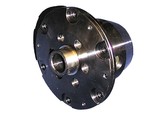Modified engines producing more power generally induce owners to drive with greater verve, particularly when competing in one of the many motorsport disciplines. In fact this isn’t isolated to modified Minis. Owners of relatively standard machinery competing in a discipline or merely out on a country lane blast are subject to the same determination. The more verve/determination applied, the more of a struggle keeping your Mini on the designated track becomes. Generally the problem is down to grip - or more precisely the lack of it.
Suspension modifications and extensive twiddling of geometry settings can provide improvements in stability, both for straight lines and turn in/mid corner performance. But even throwing bucket loads of cash at super high grade dampers, and the odd arm/leg/lung handed over to ‘professional’ chassis tuners doesn’t solve the particular grip problem we’re interested in here - corner exit/acceleration grip, or traction as it’s more commonly referred to. Maximising this is paramount as it’ll determine just how fast you get down that 1/4 mile drag strip, how quick your next lap is, how fast your elapsed time will be, whether you cover that timed section quickly enough, or simply get to mum’s for Sunday dinner on time!
After all else has been honed to perfection - including driving skills - there’s only one answer; fit an LSD. Providing your rules/pocket allow it of course! So many folk do. Unfortunately a great deal of mis-guided information, mis-understanding, and general lack of useful information generally results in said folk fitting an unsuitable unit, endowing them with more problems than they hoped to solve. Armed with the right information, selection of an LSD to suit your application will pay massive dividends.
Basic problem.
An extreme illustration of traction loss is one wheel on tarmac, the other on wet black ice. With the standard ‘open’ type diff assembly the wheel on the ice spins un-hindered, absorbing all the available drive provided by the engine. Consequently no forward motion occurs.
Cornering has the same effect, the degree to which it’ll occur largely dependent on corner speed and/or radius. The faster/tighter a corner is, the more the body rolls, lifting the inside front wheel, making it go ‘light’ - insufficient weight to keep it firmly planted on the ground - greatly reducing traction, allowing it to spin. Pressing the go pedal in the corner accentuates the situation by adding skewed roll into the equation - car pitches backwards and downwards onto outside rear wheel. Again, an open type diff transfers all available drive to the spinning wheel. Traction is lost resulting in reduced forward motion, a badly under-steering car generally accompanied by howling tyres, and the inevitable embarrassment of poor performance.
Combining both these scenarios is what makes rallying/rally-cross/grass-tracking a nightmare. Loose, traction reducing surfaces AND corners.
Problem solution.
Ancient myth has folk believing an LSD maintains drive at BOTH wheels. Mainly because, in the days of yore and latterly where money’s ‘tight’ folk either welded or locked the open-type diff solid. This certainly maintains drive to both wheels, but turns the car concerned into an uncontrollable beast not wanting to deviate from a straight ahead trajectory. In short, muscular effort of biblical proportions is needed negotiate anything resembling a corner!
Fitment of an LSD provides the salvation we’re looking for - torque bias control (cross-axle torque transfer control). Basically it transfers drive from the wheel with NO grip to the wheel that HAS grip. The LSD effectively joins the two wheels together, it’s design governing it’s capability to sense and control the torque bias required and at what rate it's applied to produce drive at the wheel with the most traction. Simplicity itself in explanation and theory.
Further complications.
Driving a vehicle where bumpy, loose or varying surface types are a feature means the LSD’s continually transferring torque across the axles from one side to the other as each wheel searches for traction. A weaving effect is created because the steering pulls one way then the other whilst traveling in a straight line (and rise to ill-informed discussions on ‘bump-steer’, a completely separate problem). Encountering a corner we get the previously outlined problem of the inside wheel going light. Drive is transferred to the outside wheel, giving the car a new in-built inclination for straight-line travel. Consequently increased driver input to the steering is required to overcome this. All the foregoing applies throughout the entire spectrum of usage, from circuit tarmac surfaces, to forestry tracks in rallying.
An LSD will also magnify any imperfections in suspension set-up or geometry, no matter how small. This would have been previously un-noticed because the standard open diff compensated for it. These imperfections encompass un-equal spring rates side to side, ineffective/worn out dampers (allowing the wheels to bobble up and down over undulating surfaces), discrepancies in geometry angles from side to side (camber, castor, track), subframes out of alignment, brakes more effective on one side, tyres differing in rolling circumference form one side to the other and un-corrected steering geometry (bump steer). All will exacerbate and exaggerate the aforementioned weaving so sorting them is imperative when using an LSD if maximum performance is sought.








